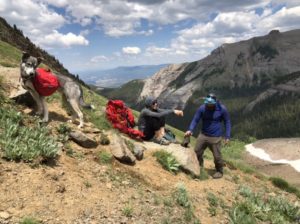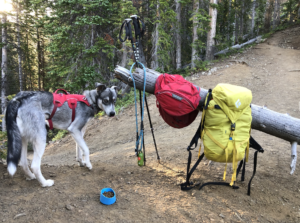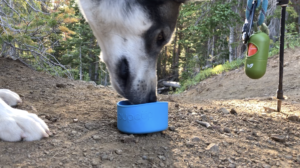If you enjoy outside as much as I do, then you probably try to hit the trails any chance you get. And there’s no one in the world who is more excited to tag along on your adventures than your furry friends. We’ve all seen those “dog people” on the trail, with their well-behaved companion at their side, willing to go anywhere their human wants to go, listening to every command they give. You’ve probably found yourself thinking, “Man, I wish my dog could do that. That would be awesome!”. Well, my friends.. It is awesome! And I’m going to break it down and tell you everything you need to know to make your pup the perfect trail dog. So let’s dive in and talk about Tips for Hiking or Backpacking with Your Dog.
Dog Gear Checklist:
- Dog Backpack
- Food
- Water
- Food/Water Bowl
- Collar/ID tags
- Leash
- Poop Bags
- Dog First Aid Kit
- Booties
- Sleep System
- Dog Towel
- Safety Light
Prepping Your Dog for the Trail
The most common mistakes made when hiking and backpacking with your dog is starting them too young and pushing them too hard too fast. Puppies bones aren’t fully developed until about a year to a year and a half of age, so until they are at that age, I would keep the hikes mild with lower miles and elevation gains, and definitely don’t have puppies carrying a load. It could cause joint problems later on down the road, that could have easily been avoided. Always ask your vet questions if you are unsure.
Talk to Your Vet
- Is your dog physically ready? You need to wait until a young dog’s bones are fully developed. That might be at a year of age, plus or minus several months, depending on size and other factors.
- Does your dog need any specific vaccinations or preventative medicines? In the city, you might not worry about things like your dog drinking water in a lake or pond that an infected animal has contaminated with Leptospirosis or even giardia. Ask the vet about preventative measures for outdoor destinations.
- Is your dog’s immune system ready? Factoring in the rate of natural immunity development and your dog’s vaccine schedule, your vet can advise you about the safe age for you two to hit the trail.
Older Dogs
If you have an older dog, their joints may not allow them to go as long and far as they once did. Although, there are some remedies out there to help alleviate their aches and pains, or inflammation in the joints. One that I would highly recommend you try is The Fauna CBD Pet Drops. If you’ve never given CBD products a try and are unsure of its legitimacy, you can check out their third-party lab results. CBD takes a bit of time to absorb in the body, so I’d start using this product as instructed about a week or so before you plan on hitting the trail, giving it time to activate, and you’ll see that pep in their step again soon enough!
Dogs with Anxiety
My boy, Blue, is an Alaskan Husky, so if you deal with separation anxiety or any kind anxiety on the trail, especially if other dogs are around, I FEEL YOU! I’d recommend trying Honest Paws. They offer all different kinds of Calming, Wellness, and Relief CBD products, whether it’s chews, bites, oils, or peanut butter (Blue’s favorite). Their reviews speak for themselves!
Key Tips
Know Your Trail Regulations: Always make sure you’re keeping up to date on the trail regulations wherever you plan on hiking or backpacking with your dog. Most national parks do not allow dogs of any kind, even on a leash. Although most national forests, state and local parks do allow dogs on their trail systems, rules may vary. But you should always keep your dog on a leash, but if you’re lucky, you’ll find places where you can let them off leash as long as they’re properly trained with voice command.
Obedience and Trail Etiquette: This is key when training the perfect trail dog! As dog owners, we have to hold a standard for all dog owners out there trying to enjoy adventures with their best friends. Always, let others have the right away, especially if they have other pets or pack animals with them. Have them on a leash, calm and collected and under control by your side. They way to go is to have a dog pack with a back handle for better control. Try to be that person who others see and think, “Man, I wish my dog could do that. That would be awesome!”.
See how I properly trained my dog with voice commands Here.
Leave No Trace: On day hikes, always pack out filled poop bags. It’s also bad form to leave them by the trail for later pickup. If you’re worried about a baggy breach, double-bag on the trail.
Pro Tip: Carry a gallon freezer ziploc bag to store the poop bags in for peace of mind and completely eliminating the smell.
On backpacking trips, humans and canines have the same Leave No Trace rule: Bury pet waste in a 6- to 8-inch hole that’s at least 200 feet away from trails, camps and water sources. Enforcing the 200-foot rule for urination breaks isn’t practical, but be prepared to interrupt things and move away if your dog begins to pee in or next to a water source.
Begin a Trail Training Regime: Ease into the routine of hiking. First, set a goal. Then, simply start with an hour long hike while monitoring energy levels and slowly increase the intensity each time you hike to give you a solid idea of what to expect on the trail. This will also allow them to toughen up those citi-fied paws and help avoid injury later on.

The Dog Backpack
When it comes down to it, a dog pack is what truly separates going on a walk from going on a hike. And trust me, they will know the difference. As soon as I pull my boy’s dog pack out, he gets all excited and sits right next to the front door, knowing we are about to go on an adventure. It’s one of my favorite parts actually, seeing him even more excited than me! For my full review on the Ruffwear Dog Pack that I use, check out Ruffwear Palisades Dog Pack: Best Dog Backpack of 2020
How to Properly Fit a Dog Pack
Measure the circumference of your dog’s chest around the widest part of the rib cage. Most packs come in a range of sizes that will correspond to this measurement. Adjust all straps to snug the pack’s fit. Don’t pull too tight, though, because, well.. your dog needs to breathe. But you also don’t want a pack that is too loose that will cause it to slip off or chafe.
For pack training, start by having your dog wear it empty around the house, then on walks. As soon as wearing the pack becomes routine, load in a few pounds (evenly on each side). This will take a few trial and error tries to get it right, but once you figure out your system, you’re good to go. Gradually increase pack weight on each walk after that until you reach your target weight. A maximum of 25 percent of body weight is a rough guideline, but factors like age, size and strength will alter that up or down. Check with your vet.
ProTip: As you feed your pet throughout your hike, be sure to evenly re-disperse the food and water on each side, before you get going again. Save yourself the hassle of feeling like you have to rearrange all the gear again.
The Rest of Your Dog Gear

First Aid Kit
Due to the fact that a vet won’t be handy in the backcountry, a doggie first-aid kit and the knowledge to use it are essential when backpacking with your dog. Organizations like the Red Cross are also a resource for dog owners, providing checklists, and selling first-aid kits, as well as training materials.
Be sure to add special medicines your vet has given you to your kit. Another handy addition is old, clean wool socks that can be taped on as “bootie bandages” if you find yourself in a bind.
Some pet owners also pack Pedialyte in case their dog gets diarrhea. Don’t do this, though, without getting both permission and dosing guidelines from your vet.
Your Sleep System
In order to allow you and your dog the space you need to have a comfortable night’s sleep, make sure your tent is big enough. If it’s a bigger dog (40+ lbs.), I would recommend counting your dog as a “person” when it comes to tent sizes. For instance, if it’s just me and my dog, I’m using my 2-person tent. Also, when it comes to the actual dog bed, there are a couple of ways you can go about it. The first way is using an actual Dog Sleeping Bag. This is recommended if your dog doesn’t have the coat to compensate for the temp changes at night.
Second, you can get creative. My boy, Blue, is an Alaskan Husky. He has more than enough hair to keep him cozy at night, so I use my old Therm-a-Rest Z Pad, which I cut in half to save weight. If I feel like he’s getting chilly at night, I’ll simply throw my down bag over both of us. Sure, I lose heat from my sleeping bag, but cuddles from my buddy compensate for the heat loss.

Other Essentials
- Dog Bowl: It’s ideal to give your dog water that you’ve packed in. Dogs will be dogs, so don’t panic if your dog finds a puddle or lake to drink out of from time to time. But learn the signs of your dog sniffing out water and provide it for them in order to deter potential parasites.
- Booties: They offer protection from sharp rocks, thorns and snow. It’s not uncommon, though, for a dog to lose a bootie. So if you choose booties rather than simply toughening up paws on training hikes, you need to pack spares. And you’ll still need to allow time for your dog to get used to wearing booties. You can find some of the best dog booties here. These are lightweight, durable, have a double velcro strap on each foot, and won’t break the bank if you had to replace them.
- Dog Towel: Trust me, after many mistakes of not carrying a dog towel with me, I learned my lesson, carry a quick dry towel with you to wipe off the muddy paws before they climb into the tent with you at night. Your gear will thank you!
- Safety Light: Some people carry dog lights such as the Ruffwear Beacon Safety Light, but I personally use my Petzl Bindi Headlamp. This is just a super light and compact headlamp that works for me, plus I have an extra headlamp if anything was to happen to mine.

Food & Water Planning
Being on the trail all day requires you to provide more food and water than your dog typically consumes.
Larger dogs might drink 0.5 to 1.0 ounces of water per pound per day. Dogs 20 pounds and lighter will be closer to 1.5 ounces per pound per day. These are general guidelines, though, so you need to be watchful and offer water often, especially on hot days. If the nose is dry, then you’re under-hydrating your dog.
The type of hike you plan on doing will determine the amount of food you’ll need. Factors such as lengthier distances and steeper elevation will require greater caloric intake, the same is true for humans when they hike. If your dog tends to wander far off, rather than stay close to you, then up the calorie count even more. Your best resource for specific food recommendations, especially if you plan a multi day trip or a thru hike, is your dog’s veterinarian.
Pro Tip: If you’re thirsty, hungry or tired, then chances are that your dog is, too. Take a break, kick back for a few so you can chow down, drink up and catch your breath together.
Trail Hazards for Dogs
Most of the trail hazards your dog will face are the same dangers you face. Only your dog will not be able to recognize many of them, let alone explain to you when something is going wrong. So make sure you’re extra vigilante of the following:
Overdoing it: Keep a close eye on your pup. How are they doing? How’s their breathing? If it seems excessive, consider taking longer breaks and shortening your hike. Limping is another sign, so routinely check their paws and pads for cuts, abrasions, etc.
Wildlife: This is where a leash and/or solid voice command practices are paramount. Protecting your pet from large carnivores, chasing deer and elk, or prancing back up to you with a face full of porcupine quills should be a no brainer. Train your pup where they’re allowed to explore and where to avoid. It’s not as hard as it seems. You can see how I trained my pup to follow voice commands Here.
Wild Plants: Halting chewing immediately is your best defense against poison or tainted plants, as well as digestive-system problems. Watch out, too, for nettles, as well as poison oak, ivy and sumac, which will cause discomfort for both you and your dog.
Thorns and burrs are irritating, but “foxtails” are more serious. Found on a variety of grasses in spring and summer, these barbed seed pods can snag on fur and end up between toes, and in more sensitive areas like nasal passages, ears, eyes and genitals.
Avoid areas with grasses that have foxtails, and remove them with tweezers right away. Excessive sneezing, head shaking, eye discharge or an abscess are a sign that it’s time to cut things short, because foxtails can work their way into a vital organ and be fatal.
Heat Stroke: Dogs can only pant and sweat through their pads to cool off. Be conservative, rest and drink often and think of using a cooling collar if your friend spends a lot of time shade hunting.
Waterborne Pathogens: Dogs are susceptible to most of the same waterborne pathogens as humans. Your safest choice is to treat water for both you and your dog. To learn more about the top water filters, read 10 Best Backpacking Water Filters of 2020.
Water Safety: If your dog can’t swim, consider packing a Dog PFD. Don’t let even a good swimmer try to cross a whitewater section of a creek: Lift and carry your dog instead (A Dog Pack with a handle on the back is key!). And be wary of turning a swimmer loose in a lake. In cool temps the wet fur can chill your dog. Even if the weather is temperate, you’ll have a major toweling-off job before bedtime.
Was This Helpful?
I hope you found this article helpful. I’ve spent 100’s of nights out in the backcountry with my dog, and I want to utilize my experiences, trial and errors, and research to better help you and your pet on your next adventure. If you have any further questions regarding hiking or backpacking with your dog, please drop me a line in the comment section below and your questions will be answered. Let me bring the information to you!
*Editor’s note: Help support this site by making your next gear purchase through one of the links above. Click a link, buy what you need, and the seller will contribute a portion of the purchase price to support TheEpicReviews unsponsored gear reviews, articles, and hiking guides. This adds no cost to my readers and I appreciate your support!
If you enjoyed this article, you may also like:
- Ruffwear Palisades Dog Pack Review: Best Dog Backpack of 2020
- Dog Care Training Collar: Best Dog Training Shock Collar
- 10 Best Backpacking Water Filters of 2020
- Top 5 Backpacking Tents of 2020
- Dow vs. Synthetic Sleeping Bags: Which is Right for You





